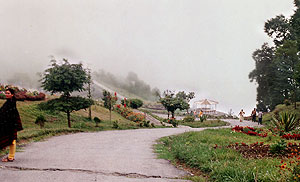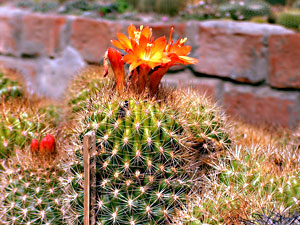|
|
|
Kalimpong, Sikkim |
|
|
|
General Information about Kalimpong
Area: 1,056.5 square kilometers
Population: 40,143
Altitude: 1,250 to 1,600 meters
Rainfall: 2030 mm (80 inches)
Season: All year round
Clothing: Tropical in Summer with a light sweater
and rainwear. Woolens in Autumn and Winter.
Language: English, Nepali, Hindi and Tibetan.
Information on Kalimpong |
 |
|
|
Kalimpong is the best hill station for the
family holiday or a honeymoon trip. Kalimpong is the largest
of the four sub-divisions of the district of Darjeeling in the
Darjeeling Gorkha Hill Council, an autonomous body within the
State of West Bengal. Kalimpong is a small sleepy hill resort
and lies in Darjeeling District. With a population of about
half a lakhs, it is ethnically and culturally similar to
Darjeeling. Kalimpong lies between the plains of the Dooars
and the hills of Darjeeling-Sikkim Himalayas. Nestling in the
lush green mid ranges of the Himalayas, this hill station of
"the Raj", has an incredible stunning backdrop of towering
snow capped peaks and offers a quiet and relaxed holiday
against the backdrop of Kanchenjunga. Kalimpong means the fort
of the Kings minister (Kalim = Kings Minister, Pong = fort).
And this name came got established when this area was under
the Bhutanese, who occupied it in 1706. Before that Kalimpong
was a part of Sikkim. Bhutan retained Kalimpong till 1865
after which it along with the Doors was ceded to British
India. Due to its ideal location at an average of 1250 meters
above mean sea level, there are mild weather conditions
throughout the year. Kalimpong has a moderate climate ranging
from between 15 to 25 Degree Celsius in Summers and 7 to 15
Degree Celsius in Winters. From spring getaways to getting wet
in the summer monsoon rains, from watching the rice harvest in
autumn to experiencing the joys of sharing a blanket in the
winter chill, Kalimpong is fast emerging as the ultimate
holiday destination in the Eastern Himalayas. English, Nepali,
Hindi and Tibetan are the main languages which are spoken in
Kalimpong. One important facet of Kalimpong as a holiday
destination is it’s year-round salubrious climate. Whether in
spring, summer, autumn or winter the visitors will find
Kalimpong a pleasant and safe place to spend a holiday. The
hub of all activity centres around the Chowrasta and the Bus
Stand in the heart of the town which abounds in good as well
as cheap hotels and restaurants. During the days yonder, it
used to be the hub of trade activity of India with Tibet and
the trade route used to be through Pedong, Rongli in Sikkim
and then the pass of Jelepa on the Sikkim – Tibet border but
Chinese invasion in 1962 put an end to all that.
History of Kalimpong
Kalimpong was once a part of the kingdom of Bhutan and the
headquarters of a Bhutanese Governor. The word 'Kalim' means
King's Minister and 'Pong' means the stronghold of the King's
minister. It is also called 'Kalibong' or the black spur by
the hill people. 'Kalipong' in local dialect stands for 'Kaulim'
which is a fibrous plant which grows in abundance in this
region. It is said that the local tribesmen or Lepcha used to
organise field sports while not engaged in agricultural
pursuits. IN 1865, after loosing out to an armed British
intervention, Bhutan ceded the territory of Kalimpong to
British India. After the Anglo-Bhutan War, it was merged with
Darjeeling, and became a sub-division of Darjeeling in 1916,
and developed as a hill station. It flourished as a wool
trading centre with Tibet till 1950, when the Chinese took
over Tibet. As Tea garden opened up in nearby Darjeeling
people from Nepal migrated in search of a livelihood. Some
spilled over to Kalimpong. The British missionaries came in
during the late 1800’s and left a legacy of good schools, high
educational standards, charitable institutions and
architectural styles reminiscent of the English countryside.
Not to mention their love for flowers and gardening. People
from mainland India came in to settle in Kalimpong and brought
with them their skills in entrepreneurship and trade. Over the
years Kalimpong slowly developed into a trading center from
which all trade to and from Tibet passed. This continued till
the mid sixties when Tibet ceased to exist as an independent
nation and the mule trains wound up. It continues to be part
of Darjeeling District, and is now an attractive tourist and
educational centre.
Culture of Kalimpong
In Kalimpong, Buddhism rubs shoulders with Hinduism and
Christianity. Gompas, churches, temples, monks and
missionaries coexist in a jovial society. Kalimpong offers
Buddhist monasteries, Hindu temples, Christian Churches,
flowers, orchids and exotic flora, old colonial bungalows,
scenic view points and the panorama of snows. This exotic town
of beautiful people, mystical and enchanting, with a rare
ethnic blend of hill people, has a tradition of hospitality
from the days of the mule caravans of olden days. As a melting
pot of such diverse and rich cultures of the people of Bhutan,
Nepal, Sikkim, Tibet, mainland India, the British and the
Lepchas (original inhabitants of the region), Kalimpong
evolved its own unique blend of a way of life from cuisine,
culture, etc. |
|
|
|
Flora in Kalimpong
Kalimpong sub-division is more or less covered by
forests and terraced agricultural land where rice, corn,
millet and seasonal vegetables are grown. Herbs and
spices like ginger, cardamom and turmeric are also grown
as a cash crop by the villagers. From tropical foothills
to the alpine regions, around 4000 flowering plant
species including more than 400 species of orchids,
trees, ferns, mosses, grasses and medicinal plants are
represented in the region. Floriculture is another major
economic activity in Kalimpong. There are various flower
nurseries, many of world renown, producing plants for
export and the home market. Cacti, Succulents, Orchids,
colourful houseplants and bulbs in many varieties are
some of |
 |
|
|
the popular
family of plants. Kalimpong flower nurseries present a
permanent year-round flower show.
Tourist Attractions in Kalimpong
The tourist attractions in Kalimpong are Thongsha Gompa, Zong
Dog Palri Fo-Brang Monastery, Tharpa Choling Monastery, Nature
Interpretation Centre, Mangal Dhaam, Colonial Bungalows, Dr.
Graham's Homes Campus, Kalimpong Arts and Crafts centre,
Dharmodaya Vihar, Kali Mandir, Gauri Pur House. There are some
panoramic snow views of Kanchenjunga, Siniolchu, Paunhari,
Lama Anden, Chola, Nathu La, Jalep La and Gymochen peaks from
Durpin Dara and Deolo View Point. Some of the popular places
like Lava, Lolaygaon, Rikkisum Pedong and Rishap are situated
within the Kalimpong sub-division and are well connected by
road from Kalimpong town. The quaint bustling bazar is a
wanderers delight and contains Buddhist Thankas, hand beaten
silver, Bhutanese weaves, Chinese lamps, Lepcha daggers,
masks.
More...
Accommodation in Kalimpong
Heritage hotels, star rated hotels, mid-range hotels, budget
hotel, guesthouses and home-stays in Kalimpong offer lodgings
for visitors in all categories.
How to reach Kalimpong
By Air:
The nearest airport is located at Bagdogra, about 80 kms. from
Kalimpong. Bagdogra is presently connected to Delhi, Guwahati
and Calcutta, by Indian Airlines and Jet Airways.
By Rail:
The nearest railheads are Siliguri 66 kms (metre gauge) and
New Jalpaiguri 80 kms (Broad gauge), which connect you to all
parts of India.
By Road:
Kalimpong is connected with New Jalpaiguri, Bagdogra, Siliguri,
Gangtok and Darjeeling. Kalimpong is 50 kms. away from
Darjeeling through Peshok and Teesta. From Siliguri it is also
possible to reach Kalimpong directly taking the road to Sikkim
till Teesta from where the route bifurcates for Kalimpong.
Note: A foreigner with the permit for Darjeeling cannot
automatically visit Kalimpong. The permit has to be got
endorsed at the Foreigners Registration Office in Darjeeling
or alternatively at the office issuing the permit. Foreigners
are normally permitted to visit Kalimpong for three days. |
|